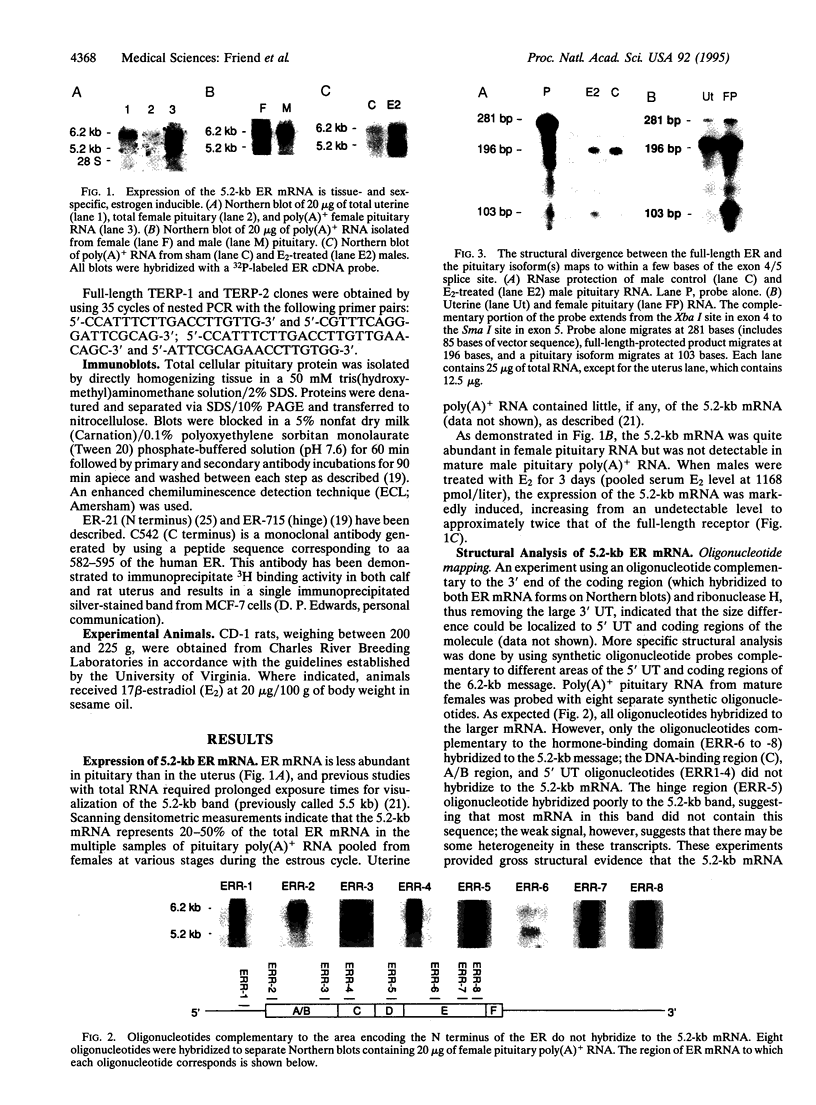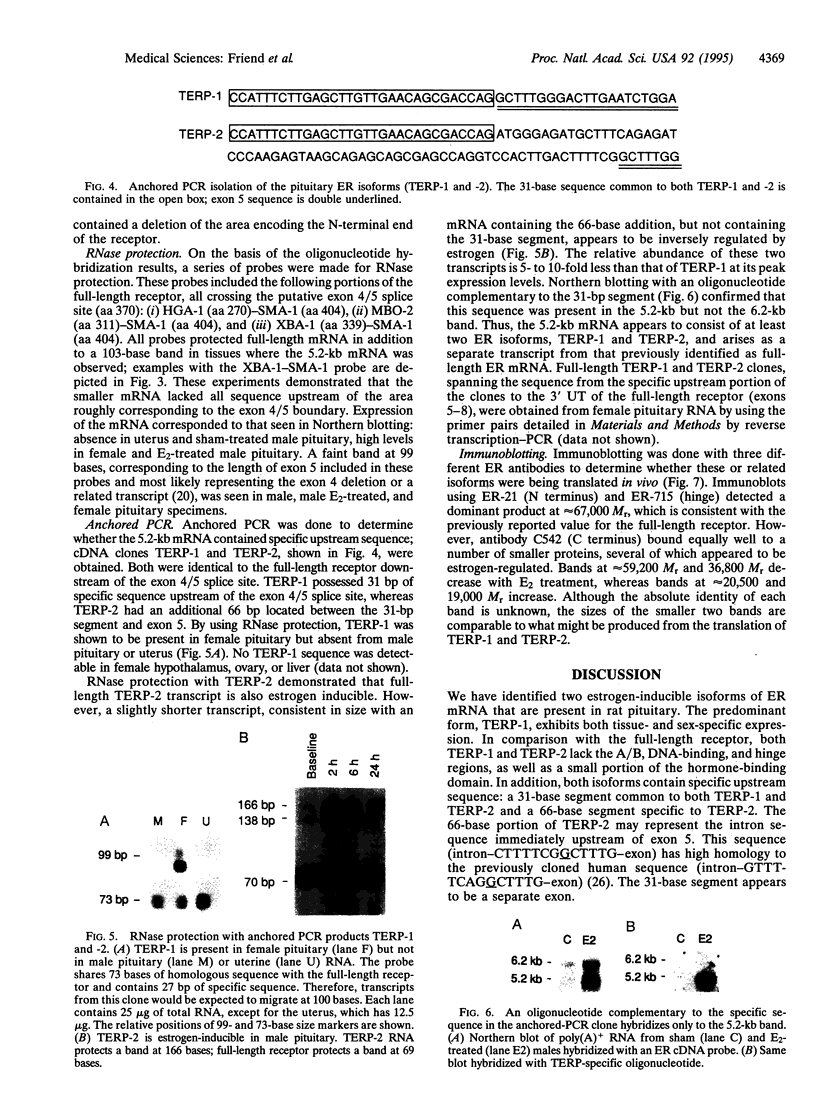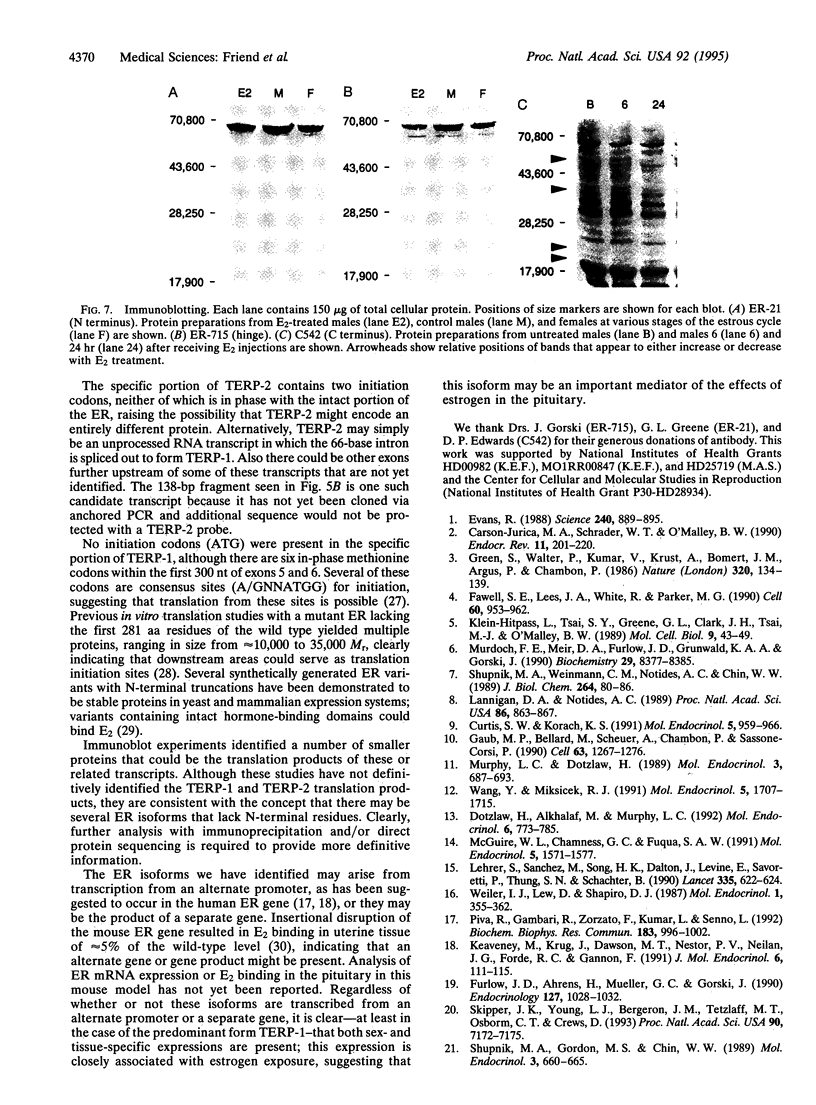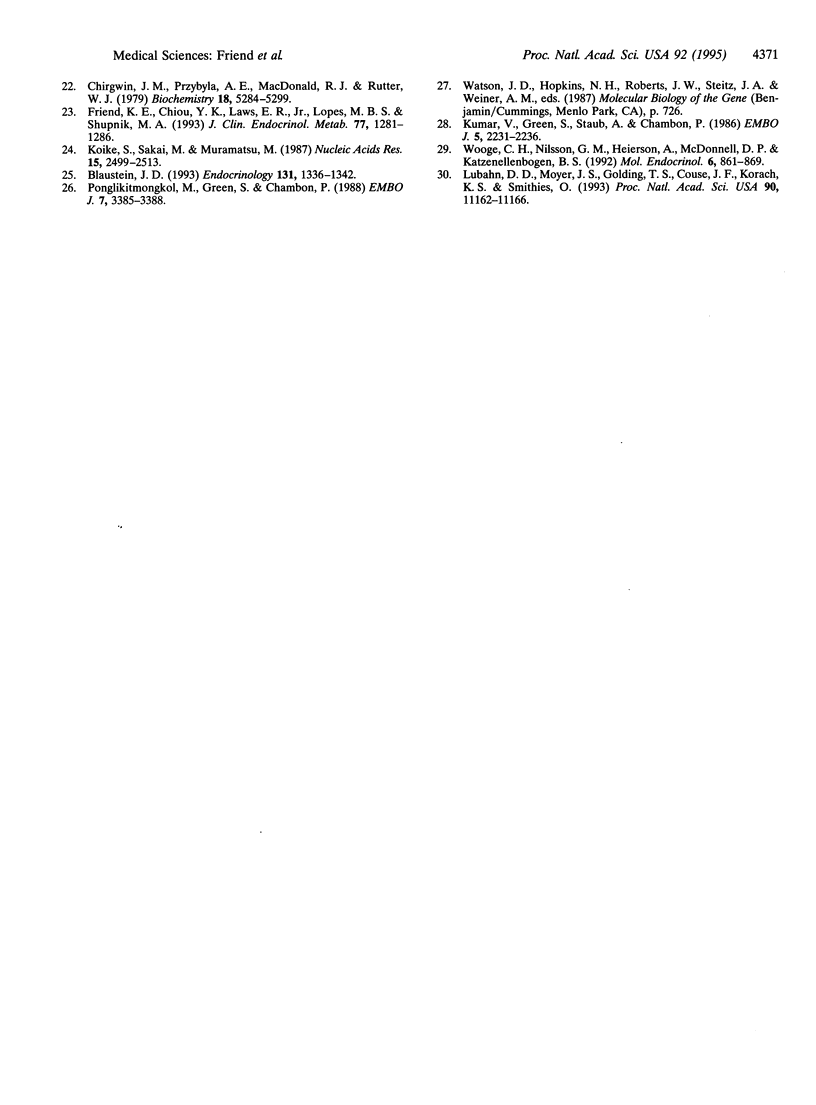Abstract
A 5.2-kb mRNA band that contains estrogen receptor (ER) sequence and exhibits sex- and tissue-specific expression has been identified in rat pituitary via Northern analysis; this band is composed of at least two distinctive ER mRNA isoforms. This mRNA is expressed in high levels in female pituitary but is absent in male pituitary and uterus, whereas the mRNA encoding the full-length receptor (6.2 kb) is expressed in all the aforementioned tissues. Estradiol treatment potently induces the expression of the 5.2-kb band in the male pituitary. Oligonucleotide hybridization and ribonuclease-protection experiments indicate that the pituitary ER variant is missing exons 1-4. Two corresponding cDNA clones, truncated estrogen receptor product 1 and 2 (TERP-1 and TERP-2), were isolated by using the anchored PCR. Both sequences contain a 31-bp segment of specific sequence upstream of exon 5; TERP-2, however, contains an additional 66 bp of specific sequence between the 31-bp segment and exon 5. On Northern analysis, probes complementary to the 31-bp segment of specific sequence hybridize only to the 5.2-kb band. Immunoblotting identified several proteins in rat pituitary that could represent the translation products of these or related transcripts. In summary, several ER isoforms have been identified that exhibit both tissue-specific expression and marked estrogen regulation and differ from full-length receptor by virtue of sequence upstream of the exon 4/5 boundary. Physiologically, the putative proteins encoded by these or similar isoforms might be important modulators of the tissue- and promoter-specific effects of estradiol.
Full text
PDF




Images in this article
Selected References
These references are in PubMed. This may not be the complete list of references from this article.
- Blaustein J. D. Cytoplasmic estrogen receptors in rat brain: immunocytochemical evidence using three antibodies with distinct epitopes. Endocrinology. 1992 Sep;131(3):1336–1342. doi: 10.1210/endo.131.3.1380440. [DOI] [PubMed] [Google Scholar]
- Carson-Jurica M. A., Schrader W. T., O'Malley B. W. Steroid receptor family: structure and functions. Endocr Rev. 1990 May;11(2):201–220. doi: 10.1210/edrv-11-2-201. [DOI] [PubMed] [Google Scholar]
- Chirgwin J. M., Przybyla A. E., MacDonald R. J., Rutter W. J. Isolation of biologically active ribonucleic acid from sources enriched in ribonuclease. Biochemistry. 1979 Nov 27;18(24):5294–5299. doi: 10.1021/bi00591a005. [DOI] [PubMed] [Google Scholar]
- Curtis S. W., Korach K. S. Uterine estrogen receptor-DNA complexes: effects of different ERE sequences, ligands, and receptor forms. Mol Endocrinol. 1991 Jul;5(7):959–966. doi: 10.1210/mend-5-7-959. [DOI] [PubMed] [Google Scholar]
- Dotzlaw H., Alkhalaf M., Murphy L. C. Characterization of estrogen receptor variant mRNAs from human breast cancers. Mol Endocrinol. 1992 May;6(5):773–785. doi: 10.1210/mend.6.5.1603086. [DOI] [PubMed] [Google Scholar]
- Evans R. M. The steroid and thyroid hormone receptor superfamily. Science. 1988 May 13;240(4854):889–895. doi: 10.1126/science.3283939. [DOI] [PMC free article] [PubMed] [Google Scholar]
- Fawell S. E., Lees J. A., White R., Parker M. G. Characterization and colocalization of steroid binding and dimerization activities in the mouse estrogen receptor. Cell. 1990 Mar 23;60(6):953–962. doi: 10.1016/0092-8674(90)90343-d. [DOI] [PubMed] [Google Scholar]
- Friend K. E., Chiou Y. K., Laws E. R., Jr, Lopes M. B., Shupnik M. A. Pit-1 messenger ribonucleic acid is differentially expressed in human pituitary adenomas. J Clin Endocrinol Metab. 1993 Nov;77(5):1281–1286. doi: 10.1210/jcem.77.5.8077322. [DOI] [PubMed] [Google Scholar]
- Furlow J. D., Ahrens H., Mueller G. C., Gorski J. Antisera to a synthetic peptide recognize native and denatured rat estrogen receptors. Endocrinology. 1990 Sep;127(3):1028–1032. doi: 10.1210/endo-127-3-1028. [DOI] [PubMed] [Google Scholar]
- Gaub M. P., Bellard M., Scheuer I., Chambon P., Sassone-Corsi P. Activation of the ovalbumin gene by the estrogen receptor involves the fos-jun complex. Cell. 1990 Dec 21;63(6):1267–1276. doi: 10.1016/0092-8674(90)90422-b. [DOI] [PubMed] [Google Scholar]
- Green S., Walter P., Kumar V., Krust A., Bornert J. M., Argos P., Chambon P. Human oestrogen receptor cDNA: sequence, expression and homology to v-erb-A. Nature. 1986 Mar 13;320(6058):134–139. doi: 10.1038/320134a0. [DOI] [PubMed] [Google Scholar]
- Keaveney M., Klug J., Dawson M. T., Nestor P. V., Neilan J. G., Forde R. C., Gannon F. Evidence for a previously unidentified upstream exon in the human oestrogen receptor gene. J Mol Endocrinol. 1991 Feb;6(1):111–115. doi: 10.1677/jme.0.0060111. [DOI] [PubMed] [Google Scholar]
- Klein-Hitpass L., Tsai S. Y., Greene G. L., Clark J. H., Tsai M. J., O'Malley B. W. Specific binding of estrogen receptor to the estrogen response element. Mol Cell Biol. 1989 Jan;9(1):43–49. doi: 10.1128/mcb.9.1.43. [DOI] [PMC free article] [PubMed] [Google Scholar]
- Koike S., Sakai M., Muramatsu M. Molecular cloning and characterization of rat estrogen receptor cDNA. Nucleic Acids Res. 1987 Mar 25;15(6):2499–2513. doi: 10.1093/nar/15.6.2499. [DOI] [PMC free article] [PubMed] [Google Scholar]
- Kumar V., Green S., Staub A., Chambon P. Localisation of the oestradiol-binding and putative DNA-binding domains of the human oestrogen receptor. EMBO J. 1986 Sep;5(9):2231–2236. doi: 10.1002/j.1460-2075.1986.tb04489.x. [DOI] [PMC free article] [PubMed] [Google Scholar]
- Lannigan D. A., Notides A. C. Estrogen receptor selectively binds the "coding strand" of an estrogen responsive element. Proc Natl Acad Sci U S A. 1989 Feb;86(3):863–867. doi: 10.1073/pnas.86.3.863. [DOI] [PMC free article] [PubMed] [Google Scholar]
- Lehrer S., Sanchez M., Song H. K., Dalton J., Levine E., Savoretti P., Thung S. N., Schachter B. Oestrogen receptor B-region polymorphism and spontaneous abortion in women with breast cancer. Lancet. 1990 Mar 17;335(8690):622–624. doi: 10.1016/0140-6736(90)90410-7. [DOI] [PubMed] [Google Scholar]
- Lubahn D. B., Moyer J. S., Golding T. S., Couse J. F., Korach K. S., Smithies O. Alteration of reproductive function but not prenatal sexual development after insertional disruption of the mouse estrogen receptor gene. Proc Natl Acad Sci U S A. 1993 Dec 1;90(23):11162–11166. doi: 10.1073/pnas.90.23.11162. [DOI] [PMC free article] [PubMed] [Google Scholar]
- McGuire W. L., Chamness G. C., Fuqua S. A. Estrogen receptor variants in clinical breast cancer. Mol Endocrinol. 1991 Nov;5(11):1571–1577. doi: 10.1210/mend-5-11-1571. [DOI] [PubMed] [Google Scholar]
- Murdoch F. E., Meier D. A., Furlow J. D., Grunwald K. A., Gorski J. Estrogen receptor binding to a DNA response element in vitro is not dependent upon estradiol. Biochemistry. 1990 Sep 11;29(36):8377–8385. doi: 10.1021/bi00488a026. [DOI] [PubMed] [Google Scholar]
- Murphy L. C., Dotzlaw H. Variant estrogen receptor mRNA species detected in human breast cancer biopsy samples. Mol Endocrinol. 1989 Apr;3(4):687–693. doi: 10.1210/mend-3-4-687. [DOI] [PubMed] [Google Scholar]
- Piva R., Gambari R., Zorzato F., Kumar L., del Senno L. Analysis of upstream sequences of the human estrogen receptor gene. Biochem Biophys Res Commun. 1992 Mar 31;183(3):996–1002. doi: 10.1016/s0006-291x(05)80289-x. [DOI] [PubMed] [Google Scholar]
- Ponglikitmongkol M., Green S., Chambon P. Genomic organization of the human oestrogen receptor gene. EMBO J. 1988 Nov;7(11):3385–3388. doi: 10.1002/j.1460-2075.1988.tb03211.x. [DOI] [PMC free article] [PubMed] [Google Scholar]
- Shupnik M. A., Gordon M. S., Chin W. W. Tissue-specific regulation of rat estrogen receptor mRNAs. Mol Endocrinol. 1989 Apr;3(4):660–665. doi: 10.1210/mend-3-4-660. [DOI] [PubMed] [Google Scholar]
- Shupnik M. A., Weinmann C. M., Notides A. C., Chin W. W. An upstream region of the rat luteinizing hormone beta gene binds estrogen receptor and confers estrogen responsiveness. J Biol Chem. 1989 Jan 5;264(1):80–86. [PubMed] [Google Scholar]
- Skipper J. K., Young L. J., Bergeron J. M., Tetzlaff M. T., Osborn C. T., Crews D. Identification of an isoform of the estrogen receptor messenger RNA lacking exon four and present in the brain. Proc Natl Acad Sci U S A. 1993 Aug 1;90(15):7172–7175. doi: 10.1073/pnas.90.15.7172. [DOI] [PMC free article] [PubMed] [Google Scholar]
- Wang Y., Miksicek R. J. Identification of a dominant negative form of the human estrogen receptor. Mol Endocrinol. 1991 Nov;5(11):1707–1715. doi: 10.1210/mend-5-11-1707. [DOI] [PubMed] [Google Scholar]
- Weiler I. J., Lew D., Shapiro D. J. The Xenopus laevis estrogen receptor: sequence homology with human and avian receptors and identification of multiple estrogen receptor messenger ribonucleic acids. Mol Endocrinol. 1987 May;1(5):355–362. doi: 10.1210/mend-1-5-355. [DOI] [PubMed] [Google Scholar]
- Wooge C. H., Nilsson G. M., Heierson A., McDonnell D. P., Katzenellenbogen B. S. Structural requirements for high affinity ligand binding by estrogen receptors: a comparative analysis of truncated and full length estrogen receptors expressed in bacteria, yeast, and mammalian cells. Mol Endocrinol. 1992 Jun;6(6):861–869. doi: 10.1210/mend.6.6.1495491. [DOI] [PubMed] [Google Scholar]








